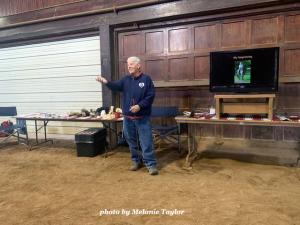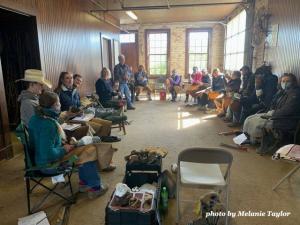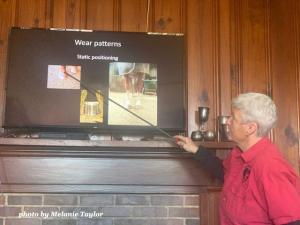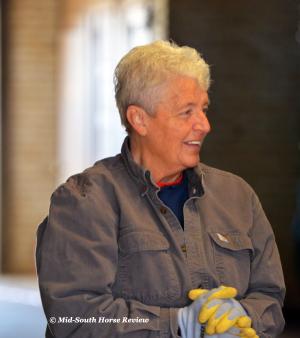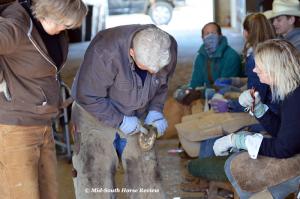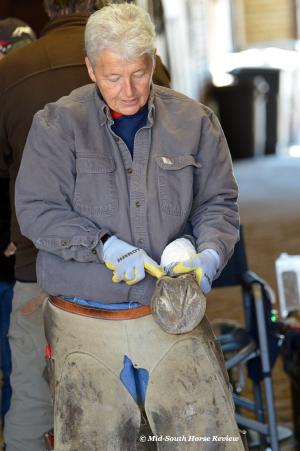By Nancy Brannon
Whole horse hoof care practitioner, educator and consultant Ida Hammer was at Wildwood Farm in Germantown, Tenn. the first weekend in March (5-7), 2021 for a three-day clinic on hoof care. Hammer is a graduate and former member of the American Association of Natural Hoof Care Practitioners (AANHCP), and has worked with Pete Ramey, as well as accumulated CE hours with Dr. Robert Bowker, Dr. Deb Taylor, the late Dr. Kerry Ridgeway, and Dr. Eleanor Kellon.
Friday was spent acquainting the 15 students with the structure and functions of the equine hoof. “The first day is an overview,” Hammer said.
Melanie Smith Taylor, owner of Wildwood Farm who also attended the clinic, described the content: “On day one, Ida’s lecture using Power Point showed the inner structures of the distal limb below the knee. Her preserved cadaver specimens of all the bones and tendons brought it all into perspective.”
The lecture also covered the factors that influence the inner structures, like diet, exercise, environment, and trimming. Hammer covered “nutrition, movement, facia, the neurological component, breeding, the spine, training and different disciplines, and more things,” said Mary Cour Burrows, organizer of the clinic who attended all three days.
She also covered heel-first vs. toe-first landings and pathologies, such as club foot, founder, navicular disease, white line disease, thrush, as well as what the farrier can do to heal these pathologies.
Pete Ramey writes about a horse landing toe-first. “When a horse is at a walk on flat terrain, each foot should impact the ground either flat (parallel with the ground), or slightly heel-first. At any faster gait, the hooves should impact heel-first, and then the toe shouldroll onto the ground after the initial impact. When the feet are impacting this way, they have tremendous shock-absorbing qualities built into their design.
“Does this mean a horse should never impact the ground toe-first? No—the locomotive system and the feet are strong enough to withstand some toe-first impacts. Healthy horses use toe-first impacts to navigate slippery terrain, to accelerate, and to travel uphill. This is normal and perfectly healthy. The real damage is done (to hooves, joints, tendons, ligaments, muscles) over time, when the horse impacts toe-first all or most of the time—this is what the horse owner needs to watch out for, as it can really shorten the horse’s usable life.”
What is the most common reason that a horse lands toe-first? Ramey answers: “The horse is avoiding impact on an overly sensitive frog. Treat any frog infections and take them seriously. Most people think of thrush (frog infections) as little more than a cosmetic flaw, but once you understand the ramifications of toe-first impact, you will realize that thrush is a serious source of lameness and quite dangerous for the horse. If a frog is so infected that you have to be careful not to cause pain with a hoof pick, how can you hope for the horse to take a sound step?
“Another thing to watch out for is excessive frog trimming at farrier visits. Often when the frog is pared down to a beautiful, slick, pretty thing, the tissue was thinned too much and this may create just enough soreness to cause a toe-first impact.”
Read more about this topic at: https://www.hoofrehab.com/WhyToe-First.html
Saturday’s clinic day was spent teaching students the basics of hoof trimming. “On day two we were all given a cadaver leg to assess and map before trimming. Ida helped each of us learn proper tool handling and trimming techniques,” Smith described. Trimming instruction focused on the use of tools, proper tool handling, and step by step applying the correct trim to the individual hoof. For examples, Hammer showed how to properly use the bonsai cutters, how to properly use a hoof knife – on both the left and right. She explained that the bars should be level with the sole, although sometimes they can be left a little higher if a horse’s particular circumstances require it. She noted that frog trimming should be kept to a minimum: “Only take off the frog any flaps or places where rocks or debris can fill in.”
After the students finished their trim, they passed around their hooves to allow others see the varieties and differences in individual hoof anatomy, and to identify vital structures, such as feeling the digital cushion. The cadaver legs and hooves showed several different kinds of hoof issues. “At the end of the class, Ida dissected one foot to further explore the anatomy of the distal limb and see it from the inside out. It was fascinating and so educational,” said Smith.
“On day three we explored hoof wear patterns on several horses. We watched movement and then Ida would make adjustments in their feet and we would watch the horse again. Videos were taken and then shown side by side on her screen. It was fascinating to observe positive changes in the whole horse in the ‘after’ pictures” described Smith.
“The third day is the class that causes you to ask questions,” Hammer explained. She videotapes a horse moving, “showing every footfall so students can see the hoof before it lands.” Hammer has students watch the horse at the walk and observe the nature of the gait and how the horse is landing on its feet.
Then students look for hoof wear patterns. “Watch for patterns of wear, which can help you recognize if the horse is compensating” for something. Then we can “pre-hab” the hoof, stop problems rather than “re-hab” the hoof after the problem develops. The farrier can change the wear pattern of the hoof by observing the way it lands.
After making changes to the hoof, Hammer videotapes the horse again. Now she can show the two videos side-by-side, showing every footfall simultaneously, before and after the trim, so students can assess what changed. Why was the horse compensating? How did the trim change the issue? The idea is to address a potential problem early on and prevent lameness.
“We videoed the horse from the side and compared frame by frame, so we could get a visual of how making the horse comfortable changed his whole body. It was amazing seeing how such small changes could have such significant impact,” Burrows recalled. “One of my favorite quotes from Ida is: ‘Nothing is all of a sudden, except trauma.’ This means that lameness takes a while to develop, and if we know what to look for, we can usually prevent it.”
Hammer was very clear in her instruction, giving concise explanations, and tempering all with a good sense of humor. She put the students at ease with any reservations they might have in trimming a hoof, and gave individualized instruction. “She is such an engaging and kind teacher,” Burrows commented. “She always puts the horse first.”
Melanie Smith Taylor shared “some of Ida’s pearls of wisdom:”
“Everything shows up in the feet that is going on in the body… and everything shows up in the body that is going on in the feet.”
“Long toes cause under run heels, which put pressure on tendons and ligaments.”
“Horses that are healing need to be with friends, to see and touch them. They need rest, and they don’t get REM sleep if they are alone and don’t feel safe. That is the horse’s nature and how he is wired.”
“Muscle memory is not muscle memory. It is memory that comes from the brain.”
Melanie’s main takeaway from Ida Hammer that she believes “sums everything up nicely” is: “No foot, No horse; Know foot, Know horse!”
Hammer was pleased with the turnout and her reception in the mid-south area. She travels all over the U.S. giving clinics and anticipates making Germantown, Tenn. a regular clinic stop in the future.
Read more about Ida Hammer and her clinics at: https://mackinawdells2.com.
Whole horse hoof care practitioner, educator and consultant Ida Hammer was at Wildwood Farm in Germantown, Tenn. the first weekend in March (5-7), 2021 for a three-day clinic on hoof care. Hammer is a graduate and former member of the American Association of Natural Hoof Care Practitioners (AANHCP), and has worked with Pete Ramey, as well as accumulated CE hours with Dr. Robert Bowker, Dr. Deb Taylor, the late Dr. Kerry Ridgeway, and Dr. Eleanor Kellon.
Friday was spent acquainting the 15 students with the structure and functions of the equine hoof. “The first day is an overview,” Hammer said.
Melanie Smith Taylor, owner of Wildwood Farm who also attended the clinic, described the content: “On day one, Ida’s lecture using Power Point showed the inner structures of the distal limb below the knee. Her preserved cadaver specimens of all the bones and tendons brought it all into perspective.”
The lecture also covered the factors that influence the inner structures, like diet, exercise, environment, and trimming. Hammer covered “nutrition, movement, facia, the neurological component, breeding, the spine, training and different disciplines, and more things,” said Mary Cour Burrows, organizer of the clinic who attended all three days.
She also covered heel-first vs. toe-first landings and pathologies, such as club foot, founder, navicular disease, white line disease, thrush, as well as what the farrier can do to heal these pathologies.
Pete Ramey writes about a horse landing toe-first. “When a horse is at a walk on flat terrain, each foot should impact the ground either flat (parallel with the ground), or slightly heel-first. At any faster gait, the hooves should impact heel-first, and then the toe shouldroll onto the ground after the initial impact. When the feet are impacting this way, they have tremendous shock-absorbing qualities built into their design.
“Does this mean a horse should never impact the ground toe-first? No—the locomotive system and the feet are strong enough to withstand some toe-first impacts. Healthy horses use toe-first impacts to navigate slippery terrain, to accelerate, and to travel uphill. This is normal and perfectly healthy. The real damage is done (to hooves, joints, tendons, ligaments, muscles) over time, when the horse impacts toe-first all or most of the time—this is what the horse owner needs to watch out for, as it can really shorten the horse’s usable life.”
What is the most common reason that a horse lands toe-first? Ramey answers: “The horse is avoiding impact on an overly sensitive frog. Treat any frog infections and take them seriously. Most people think of thrush (frog infections) as little more than a cosmetic flaw, but once you understand the ramifications of toe-first impact, you will realize that thrush is a serious source of lameness and quite dangerous for the horse. If a frog is so infected that you have to be careful not to cause pain with a hoof pick, how can you hope for the horse to take a sound step?
“Another thing to watch out for is excessive frog trimming at farrier visits. Often when the frog is pared down to a beautiful, slick, pretty thing, the tissue was thinned too much and this may create just enough soreness to cause a toe-first impact.”
Read more about this topic at: https://www.hoofrehab.com/WhyToe-First.html
Saturday’s clinic day was spent teaching students the basics of hoof trimming. “On day two we were all given a cadaver leg to assess and map before trimming. Ida helped each of us learn proper tool handling and trimming techniques,” Smith described. Trimming instruction focused on the use of tools, proper tool handling, and step by step applying the correct trim to the individual hoof. For examples, Hammer showed how to properly use the bonsai cutters, how to properly use a hoof knife – on both the left and right. She explained that the bars should be level with the sole, although sometimes they can be left a little higher if a horse’s particular circumstances require it. She noted that frog trimming should be kept to a minimum: “Only take off the frog any flaps or places where rocks or debris can fill in.”
After the students finished their trim, they passed around their hooves to allow others see the varieties and differences in individual hoof anatomy, and to identify vital structures, such as feeling the digital cushion. The cadaver legs and hooves showed several different kinds of hoof issues. “At the end of the class, Ida dissected one foot to further explore the anatomy of the distal limb and see it from the inside out. It was fascinating and so educational,” said Smith.
“On day three we explored hoof wear patterns on several horses. We watched movement and then Ida would make adjustments in their feet and we would watch the horse again. Videos were taken and then shown side by side on her screen. It was fascinating to observe positive changes in the whole horse in the ‘after’ pictures” described Smith.
“The third day is the class that causes you to ask questions,” Hammer explained. She videotapes a horse moving, “showing every footfall so students can see the hoof before it lands.” Hammer has students watch the horse at the walk and observe the nature of the gait and how the horse is landing on its feet.
Then students look for hoof wear patterns. “Watch for patterns of wear, which can help you recognize if the horse is compensating” for something. Then we can “pre-hab” the hoof, stop problems rather than “re-hab” the hoof after the problem develops. The farrier can change the wear pattern of the hoof by observing the way it lands.
After making changes to the hoof, Hammer videotapes the horse again. Now she can show the two videos side-by-side, showing every footfall simultaneously, before and after the trim, so students can assess what changed. Why was the horse compensating? How did the trim change the issue? The idea is to address a potential problem early on and prevent lameness.
“We videoed the horse from the side and compared frame by frame, so we could get a visual of how making the horse comfortable changed his whole body. It was amazing seeing how such small changes could have such significant impact,” Burrows recalled. “One of my favorite quotes from Ida is: ‘Nothing is all of a sudden, except trauma.’ This means that lameness takes a while to develop, and if we know what to look for, we can usually prevent it.”
Hammer was very clear in her instruction, giving concise explanations, and tempering all with a good sense of humor. She put the students at ease with any reservations they might have in trimming a hoof, and gave individualized instruction. “She is such an engaging and kind teacher,” Burrows commented. “She always puts the horse first.”
Melanie Smith Taylor shared “some of Ida’s pearls of wisdom:”
“Everything shows up in the feet that is going on in the body… and everything shows up in the body that is going on in the feet.”
“Long toes cause under run heels, which put pressure on tendons and ligaments.”
“Horses that are healing need to be with friends, to see and touch them. They need rest, and they don’t get REM sleep if they are alone and don’t feel safe. That is the horse’s nature and how he is wired.”
“Muscle memory is not muscle memory. It is memory that comes from the brain.”
Melanie’s main takeaway from Ida Hammer that she believes “sums everything up nicely” is: “No foot, No horse; Know foot, Know horse!”
Hammer was pleased with the turnout and her reception in the mid-south area. She travels all over the U.S. giving clinics and anticipates making Germantown, Tenn. a regular clinic stop in the future.
Read more about Ida Hammer and her clinics at: https://mackinawdells2.com.
